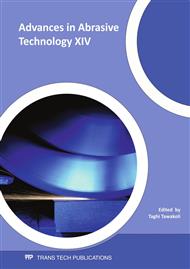[1]
J.F.G. Oliveira, E.J. Silva, C. Guo, F. Hashimoto, Industrial challenges in grinding, Annals of the CIRP 58 (2009) 663-680.
DOI: 10.1016/j.cirp.2009.09.006
Google Scholar
[2]
I. D. Marinescu, W. B. Rowe, B. Dimitrov, I. Inasaki: Trybology of abrasive machining (William Andrews publishing, 2004).
Google Scholar
[3]
D.A. Doman, A. Warkentin and R. Bauer, Finite element modeling approaches in grinding, International Journal of Machine Tools & Manufacture 49 (2009) 109–116.
DOI: 10.1016/j.ijmachtools.2008.10.002
Google Scholar
[4]
E. Brinksmeier, J. C. Aurich, E. Govekar, C. Heinzel, H. -W. Hoffmeister, F. Klocke, J. Peter, R. Rentsch, D. J. Stephenson, E. Uhlmann, K. Weinert, M. Witmann, Advances in Modeling and Simulation of Grinding Processes, Annals of the CIRP 55 (2006).
DOI: 10.1016/j.cirp.2006.10.003
Google Scholar
[5]
R. P. Upadhyaya, S. Malkin, Thermal aspects of grinding with electroplated CBN wheels, Tans. ASME. Journal of Manufacturing Science Engineering 126 (2004) 107-114.
DOI: 10.1115/1.1644547
Google Scholar
[6]
A. Lefebvre, P. Vieville, P. Lipinski, C. Lescalier. Numerical Analysis of grinding temperature measurement by the foil/workpiece thermocouple method, International Journal of Machine Tools & Manufacture, 46 (2006) 1716-1726.
DOI: 10.1016/j.ijmachtools.2005.12.009
Google Scholar
[7]
T. Kuriyagawa, K. Syoji, H. Ohshita, Grinding temperature within contact arc between wheel and workpiece in high-efficiency grinding of ultrahard cutting tool materials, Journal of Materials Processing Technologies, 136 (2003) 39-47.
DOI: 10.1016/s0924-0136(02)00842-7
Google Scholar
[8]
I. Zarudi, L. C. Zhang, A revisit to some wheel-workpiece interaction problems in surface grinding, International Journal of Machine Tools & Manufacture, 42 (2002) 905-913.
DOI: 10.1016/s0890-6955(02)00024-x
Google Scholar
[9]
X. Xu, S. Malkin Comparison of Methods to Measure Grinding Temperatures, Trans. ASME, Journal of Manufacturing Science Enggineering, 123 (2001) 191-195.
DOI: 10.1115/1.1369358
Google Scholar
[10]
T. Jin, D. J. Stephenson, Three Dimensional Finite Element Simulation of transient Heat Transfer in High Efficiency Deep Grinding, Annals of the CIRP. 53/1 (2004) 259-262.
DOI: 10.1016/s0007-8506(07)60693-3
Google Scholar
[11]
A. D: Batako, W. B. Rowe, M. N. Morgan, Temperature measurement in high efficiency deep grinding, International Journal of Machine Tools & Manufacture, 45 (2005) 1231-1245.
DOI: 10.1016/j.ijmachtools.2005.01.013
Google Scholar
[12]
J. A. Sánchez, I. Pombo, R. Alberdi, B. Izquierdo, N. Ortega, S. Plaza, J. Martínez-Toledano, Machining evaluation of a hybrid MQL-CO2 grinding technology, Journal of Cleaner Production, 18 (2010) 1840-1849.
DOI: 10.1016/j.jclepro.2010.07.002
Google Scholar


